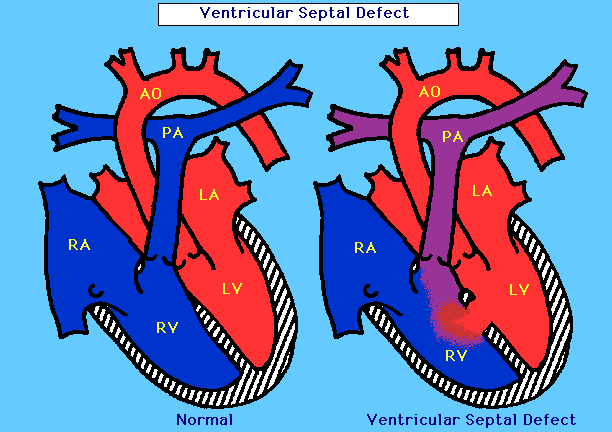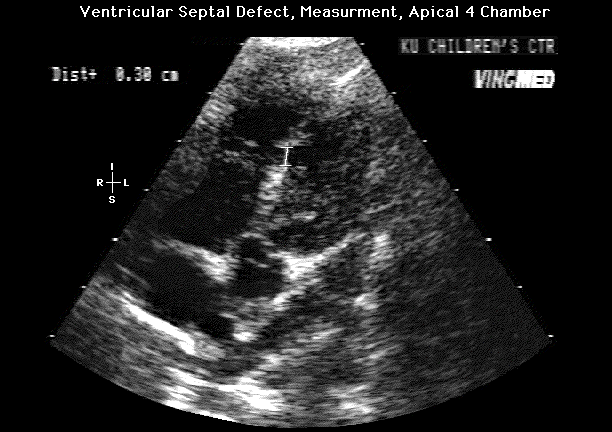
[ASD] [VSD] [PDA] [Coarctation] [Tetralogy of Fallot] [Pulmonary Atresia] [Tricuspid Atresia] [HLHS] [Transposition] [DORV] [TAPVC] [AV Canal] [Pulmonary Stenosis] [Truncus Arteriosus] [Ebstein's Anomaly] [Coronary Anomalies] [Single Ventricle]
Please wait ! Before you proceed further, have you READ MY DISCLAIMER ? If not, DO IT NOW....or proceed at your own risk.

By now, I guess, you know exactly what the heart is, so we can move on to the next issue - and that's heart defects. ....
INTERRUPTION
WHAT ?! You DON'T !
That's alright .... If you DON'T KNOW or HAVE FORGOTTEN about the heart, just go back and READ MY ARTICLE on "What is the Heart ?" Then come back, and we'll continue. Hurry up and get back soon !
Sorry about that interruption. As I was saying, we can now go on to see what are VENTRICULAR SEPTAL DEFECTS.
I have discussed atrial septal defects before. Well, ventricular septal defects - also called VSD - are similar. A VSD is a "hole" in the wall between the two lower chambers of the heart - the ventricles. This hole may be small, medium-sized or large, and may be single or multiple. It may occur in different parts of the wall, and may sometimes be found along with other heart defects.
Here is a picture of a VSD

The wall between ventricles is meant to separate blood passing through each. This is to prevent mixing of "impure" blood from the veins with "pure" blood going to the
Because of this flow from left to right ventricle across the VSD - also called a LEFT to RIGHT SHUNT - more blood than normal flows into the lungs. Just as in atrial septal defects (ASD), this causes frequent "chest colds" and breathing difficulty in children. When the VSD is large, in a very small child, lung blood flow may be so enormous that the tiny ventricles cannot pump such a volume. This causes HEART FAILURE. Heart failure in a child produces rapid shallow breathing, excessive sweating, inability to feed well, irritability, constant crying, and a failure to grow normally.
Have you felt a kitten purring ? Well, here's something interesting about these children with VSD. When you place your hand over their chest, there is a sensation just like that - called a THRILL. It is produced by the forceful flow of blood across the VSD !
One effect seen in VSD - but not in ASD - is the rapid development of changes in the blood vessels of the lungs. These arteries and veins become thick walled and hard early in life. The reason for this is perhaps because blood from the left ventricle, which is the most powerful chamber of the heart, is pumped under high pressure across the VSD into the lungs. To withstand such force, the tubes carrying blood become thick and strong.
The changes I have just described keep progressing. Soon the heart fails to keep up with the high blood flow, and heart failure sets in. When the lung blood vessels become very thick, the problem of PULMONARY HYPERTENSION arises. This is a situation where the lung arteries are severely damaged, and at this stage, even surgical repair of the VSD will not be able to cure the disease. When the VSD is located in the upper part of the inter-ventricular wall, close to the aortic valve, it can slowly make the aortic valve "leaky" - a condition called AORTIC REGURGITATION. This usually takes many years. In small VSD's, none of these things are seen often. But there is one complication peculiar to a small VSD - INFECTIVE ENDOCARDITIS. Due to a jet of blood across the VSD, the inner lining of the heart gets damaged. Bacteria can infect this injured layer easily.
VSD may be found alone, as the only defect in a heart that is otherwise normal. Or it may form a part of a "complex" of abnormalities. In this case, it may produce different effects. Some examples of such diseases are TETRALOGY of FALLOT, TRANSPOSITION of the GREAT VESSELS and DOUBLE OUTLET RIGHT VENTRICLE. To avoid confusion, I will describe these conditions separately in other articles.
This is an Echocardiogram of a patient with VSD

There is another special thing about VSD's. Some of them close even without any treatment ! There is yet no way to definitely predict which ones will close. The best chance for closure is in the first six months of life. After this, spontaneous closure becomes rarer. If by the tenth year of life the VSD has not closed by itself, it needs to be repaired.
There is one exception to this rule - the SMALL VSD. There is still much controversy about this defect. While surgeons advise that small VSD's be repaired, cardiologists usually recommend "no treatment". The arguments against repair are the small risk and discomfort involved with surgery, and the absence of any symptoms in patients. The surgeons however claim that
This is yet another area where decision making is very complex. Factors to be considered are the age of the patient, size and location of the VSD, severity of lung vessel blood pressure and the degree of symptoms of heart disease.
In very small babies with severe heart failure, usually with large VSD, IMMEDIATE repair usually cannot be avoided. If there is no heart failure, however, repair is postponed until SIX MONTHS of age. The reason for this is that a certain number of VSD's will close naturally by this time. Beyond six months, the decision to close a VSD is based on measurement of PULMONARY VASCULAR RESISTANCE - that is, the degree of damage to lung blood vessels. If the damage is less, closure is strongly recommended. If the damage is severe, repair of the VSD may actually be more HARMFUL than not doing anything at all ! These patients have crossed the boundary of "operability".
With medium-sized VSD's, a longer waiting period is possible. If even after five to ten years the VSD has not closed, repair is justified. A special group is the VSD's that are just below the aortic valve. Because of the risk of the valve becoming "leaky" in these patients, earlier repair - before five years - is better.
NOTE: A lot of controversy still surrounds issues related to closure of VSD. The facts I have mentioned above are only currently "accepted guidelines". The decision about which treatment option is best for a particular case is best made by the physician who analyzes all the factors.
As always, surgical closure by an open heart operation is the "tried and tested" approach for VSD. The surgeon may close the VSD by opening the right atrium or ventricle, or maybe the pulmonary artery or aorta. Rarely, when multiple VSD's are present - the so-called SWISS CHEESE VENTRICULAR SEPTUM - an access through the left ventricle is preferred.
In small VSD, simple stitching of the hole with thread made of POLYPROPYLENE or similar material is enough. When the defect is large, a synthetic "patch" made of a fabric like dacron or Gore-tex is used. Interestingly, some surgeons have used a kind of "glue" to simply plug any holes in the wall !
This is the era of "minimal access repair". In keeping with this trend, the "catheter-pushers" (or INTERVENTIONAL CARDIOLOGISTS, if you prefer that term) have developed a way to close VSD using catheters. Through a narrow plastic tube - called a catheter - threaded into an artery by a needle-stick in the groin or fore-arm, a special device is guided into the heart. This umbrella-like device is passed across the VSD and opened. The umbrella closes the VSD, and it is fixed in place ! Though elegant, this method is still under evaluation. If found equally effective, this may replace surgery in closure of small VSD's.
Not ABSOLUTELY, but yes, it is reasonably safe. Life isn't perfect after all ! Most complications are not serious. There may be excessive bleeding requiring a blood transfusion. Infection may occur and be treated by medicines. The risk of death due to operation is very low, and in most hospitals will be below 2%, except in very sick patients with a large VSD and other defects, when it is a little higher. There is however one problem that used to be seen often in older times, but which still may happen. This is an arrhythmia called HEART BLOCK.
What is heart block ? As we have seen earlier, the weak electrical current inside the heart follows a definite path. This part is marked out by CONDUCTION TISSUE - a special kind of cell designed to "conduct" or carry current. The conduction tissue of the heart passes very CLOSE to the margins of some VSD's. When stitches to repair the VSD are applied, they may injure this conduction tissue. As a result, electric impulses will not be carried normally, and will get "blocked". This is called heart block. In some cases, it will recover naturally within a week or two. But in some it does not, and needs implantation of an ARTIFICIAL PACEMAKER - a device that delivers an electric current and sets the "pace" of the heart !
Fortunately, very well. Most children lead normal lifestyles. Very few restrictions apply. For instance, if they have had surgery through an incision through the middle of the chest, that has split the breast-bone, they are limited from playing rough contact sports for fear of breaking the weak bone. If a synthetic "patch" has been used to close the VSD, some medicines may need to be taken for the first few weeks after operation to prevent blood clotting on the patch. Even later on, before some minor operations or medical tests - like before having a tooth removed - some medicines called ANTIBIOTICS may need to be taken for a day or two, to decrease the risk of infection on the patch. During any illness in the future, don't forget to mention to the doctor that a patient has had operation for a VSD ! Other than this, VSD-repaired patients have an almost normal life.
So that's about all of things you need to know of VSD. If you can't understand some of it, don't panic - most normal people wouldn't too ! Heart disease is quite complex, and it takes years and years of studying it to get a clear picture. If there's anything more you want to know, or some areas which aren't clear enough, don't hesitate to LET ME KNOW, and I'll try and make it easier to understand.

I hope you enjoyed reading this piece as much as I did writing it !
 Let me know what you think about it. Fill in my "Self-Assessment Form". Or just E-Mail me at "sivaraj@giasmd01.vsnl.net.in".
Let me know what you think about it. Fill in my "Self-Assessment Form". Or just E-Mail me at "sivaraj@giasmd01.vsnl.net.in".